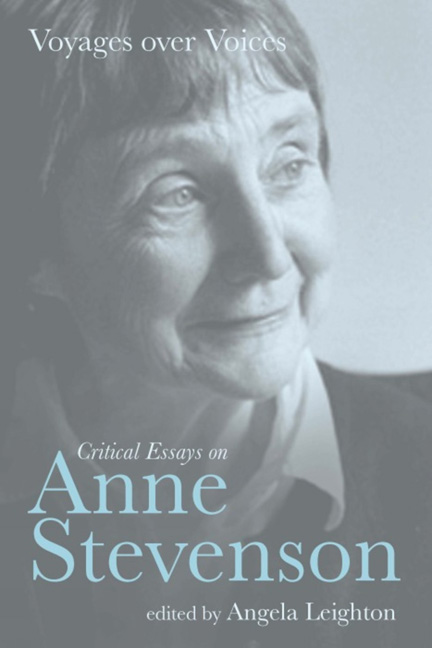Book contents
- Frontmatter
- Contents
- Notes on Contributors
- Acknowledgements
- ‘Making Poetry’
- 1 ‘Voyages over voices’: Introduction
- 2 The Melting Metaphor
- 3 ‘Between us’: Letters and Poems of Stevenson and Bishop
- 4 Mothers, Mirrors, Doubles: Anne Stevenson's Elegies for Sylvia Plath
- 5 Staging Second Thoughts: The Poetry of Anne Stevenson
- 6 ‘Making Poetry’: The Exemplary Anne Stevenson
- 7 ‘A curved adventure’: Romanticism and the Poetry of Anne Stevenson
- 8 The Nature of Anne Stevenson
- 9 Anne Stevenson and the Poetry of Place
- 10 Compacting Time: Anne Stevenson's Poems of Memory
- 11 ‘Not exactly a persona’: Pronouns in Anne Stevenson's Poetry
- 12 ‘To serve a girl on terrible terms’: Anne Stevenson's Writing Selves
- 13 Talking and Singing: Anne Stevenson's Variations on a Rhythmical Theme
- 14 ‘Time will erase’: Anne Stevenson and Elegy
- 15 Observing the Overhearing: The Anne Stevenson Papers in Cambridge University Library
- 16 Bibliography of Anne Stevenson's Published Works
- General Index
- Index of Stevenson's Works
11 - ‘Not exactly a persona’: Pronouns in Anne Stevenson's Poetry
- Frontmatter
- Contents
- Notes on Contributors
- Acknowledgements
- ‘Making Poetry’
- 1 ‘Voyages over voices’: Introduction
- 2 The Melting Metaphor
- 3 ‘Between us’: Letters and Poems of Stevenson and Bishop
- 4 Mothers, Mirrors, Doubles: Anne Stevenson's Elegies for Sylvia Plath
- 5 Staging Second Thoughts: The Poetry of Anne Stevenson
- 6 ‘Making Poetry’: The Exemplary Anne Stevenson
- 7 ‘A curved adventure’: Romanticism and the Poetry of Anne Stevenson
- 8 The Nature of Anne Stevenson
- 9 Anne Stevenson and the Poetry of Place
- 10 Compacting Time: Anne Stevenson's Poems of Memory
- 11 ‘Not exactly a persona’: Pronouns in Anne Stevenson's Poetry
- 12 ‘To serve a girl on terrible terms’: Anne Stevenson's Writing Selves
- 13 Talking and Singing: Anne Stevenson's Variations on a Rhythmical Theme
- 14 ‘Time will erase’: Anne Stevenson and Elegy
- 15 Observing the Overhearing: The Anne Stevenson Papers in Cambridge University Library
- 16 Bibliography of Anne Stevenson's Published Works
- General Index
- Index of Stevenson's Works
Summary
In an interview for Oxford Poetryin 1983, Anne Stevenson explores the role of the personal pronoun in her work, explaining that ‘the “I” I write as is not really the “I” I know, or other people know. It's not exactly a persona, this “I” in the poems. It's more a reflection in a mirror.’ Her claim that she does not know, and others do not recognise, this reflected version of herself, coupled with her assertion that it does not refer to a fictional ‘persona’ either, is intriguing. This foreign mirror image is halfway between an autonomous figure, without personal accountability, and an autobiographical projection of the poet's own self. That Stevenson's poetry is, as Sean O'Brien notes, ‘inseparable from life’ is certainly evident in the numbers of dates and place names included in the titles and texts of her poems, while an early essay, ‘Writing as a Woman’ (1979), discusses for instance how the personal experiences of raising a family and coping with domesticity found their way into the poet's early work.
In a later interview, she again uses the act of looking at her reflection to suggest a relationship between self and other, the known and the unknown. It was like, she suggests, ‘the surrealistic effect you get when looking through a window at night. You can see through the glass to the trees or buildings outside; at the same time you also see your face, or really, through your face.’ This appears to challenge the apparent rupture between herself and the mirror image in the previous quotation. She now recognises herself in the glass, while also looking through herself to the world beyond. ‘You’ has the capacity to represent a presence that is both opaque and transparent, there and not there. Such pronouns, therefore, create their own drama in poems that draw on life's experiences. While they do not initially attract attention to themselves, the tensions they create often lie at the heart of Stevenson's poetic purpose.
- Type
- Chapter
- Information
- Voyages over VoicesCritical Essays on Anne Stevenson, pp. 164 - 172Publisher: Liverpool University PressPrint publication year: 2010



